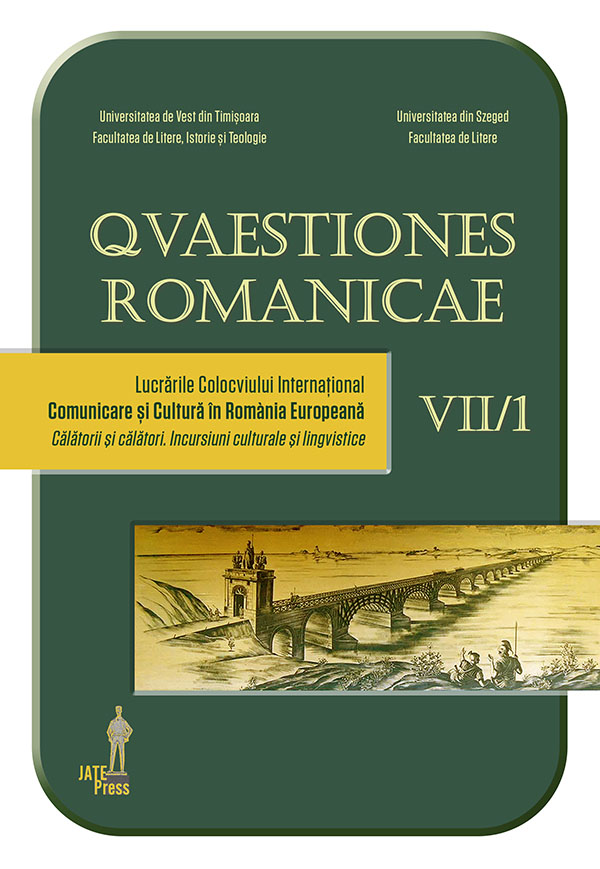Transylvanie, la frontière distante. Karpathia de Mathias Menegoz (2014) et La Transylvanie et ses habitants de Auguste de Gérando (1845-1847)
Abstract: Transylvania - Ardeal, Erdélyi, Siebenbürgen - fascinates the Western World for centuries. This fascination is rooted in myths and legends, as well as in somehow uncertain historical writings. The tutelary figure of Vlad the Impeller dominates the Transylvanian iconography in the West to the point of obscuring the multicultural and multilingual wealth of this land. The complexity and beauty of this remote land are more than often supplanted by the image of the blood-thirsty monster created by Bram Stoker or by the one of Rudolph de Gortz in Jules Verne’s Transylvanian novel. Transylvania is the victim of clichés that Hollywood has further heightened. Before the Gothic fantasies of these two writers, some French-speaking travellers had visited this region without focusing on a so-called lugubrious atmosphere present there. Élisée Reclus published a travelogue in 1874 in a magazine entitles “Le Tour du monde” in Paris, but more importantly, Auguste de Gérando published two volumes, La Transylvanie et ses habitants (Transylvania and its inhabitants) a few years before the onset of the Spring of the People – Gérandi had married a Transylvanian aristocrat from a leading Hungarian family, the Telekis de Szek, and had moved to their estate near Satu Mare. His book depicts in detail this remote province of the Habsburg Empire, proud of its specificity but living somehow outside the said empire due to its deep singularity. This Transylvania can be found in Mathias Menegoz’s novel which tells the story of a Hungarian aristocrat in 1833 who decides to move to his ancestral estate he has never visited after fighting a duel in Vienna, and taking his young Austrian bride with him and to their final downfall. If Menegoz’s novel is interesting because of its renewal of the Historical novel genre in France, it is also the case because of the author’s detailed depiction of the Transylvanian ethnic patchwork, the tensions and hatred between the three “Nations” and the Vlach majority. Even if the plot does not entirely dismiss a certain clichéd iconography present in Jules Verne’s The Carpathian Castle, but its main focus is the dynamics at work in this remote borderland. This article draws a parallel between these two books, De Gérando’s fine observations echoing the historical ones developed by Menegoz. One can find in both books the reasons for the 1848 explosion but also the difficulty to reconcile the interests of various groups dominated by a Hungarian aristocracy far too often jealous of its privileges – what Miklós Banffy will describe in its Transylvanian Trilogy in the 1930s.
Keywords: Transylvania, the novel Karpathia, Mathias Menegoz, Auguste de Gérando.
Résumé: La Transylvanie - Ardeal, Erdélyi, Siebenbürgen - fascine l’Occident depuis de nombreux siècles. Cette fascination se fonde sur des mythes et des légendes, ainsi que sur des récits historiques plus ou moins vérifiés. La figure tutélaire de Vlad l’Empaleur domine entièrement l’iconographie transylvaine en Occident au point d’en faire oublier la richesse de cette terre multiculturelle et multilingue. La complexité et la beauté de cette terre lointaine sont bien trop souvent supplantées par l’image du monstre sanguinaire imaginé par Bram Stoker ou par celle de Rodolphe de Gortz chez Jules Verne. La Transylvanie souffre de ces clichés dont Hollywood s’est emparé. Avant les fantaisies « gothiques » de ces deux écrivains, certains voyageurs francophones avaient parcouru cette région sans en souligner son aspect soi-disant lugubre. Élisée Reclus publia un journal de bord en 1874 dans la revue « Le Tour du monde » de Paris, mais de façon plus importante encore, Auguste de Gérando publia deux volumes intitulés La Transylvanie et ses habitants en 1845 à l’orée du printemps des peuples - Gérando avait épousé une aristocrate transylvaine magyare de la prestigieuse famille Teleki de Szek et s’était installé dans leur domaine proche de Satu Mare. Son livre décrit en détail une province éloignée de l’empire Habsbourg, fière de sa spécificité mais vivant très en dehors du reste dudit empire, cultivant sa singularité profonde. Cette Transylvanie, on la retrouve dans le roman de Mathias Menegoz qui narre les aventures d’un aristocrate magyar en 1833 qui décide de s’installer dans ses domaines ancestraux inconnus de lui après un duel à Vienne, entraînant dans sa course, et sa chute, sa jeune épouse autrichienne. Si l’intérêt du roman de Menegoz se situe dans le renouveau en France de la fresque historique, il se place également dans sa description détaillée de la mosaïque ethnique transylvaine, des tensions et haines entre les trois « nations » et la majorité « valaque ». Si l’intrigue ne peut parfois échapper à l’iconographie transylvaine du Château des Carpathes, elle s’intéresse surtout à la dynamique particulière de cette frontière distante. Notre article établit un parallèle entre ces deux ouvrages: les fines observations de Gérando semblant faire écho à celles, historiques, de Menegoz. On retrouve dans les deux livres les raisons de l’explosion de 1848 mais aussi la difficulté de concilier les intérêts de trop nombreux groupes dominés par une aristocratie magyare bien souvent accrochée à ses privilèges - ce que Miklós Banffy décrira fort bien dans sa Trilogie transylvaine dans les années 1930.
Mots-clés : Transylvanie, le roman Karpathia, Mathias Menegoz, Auguste de Gérando.
